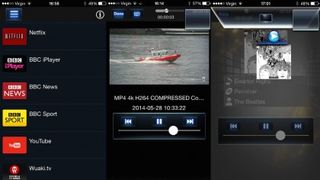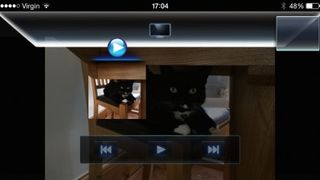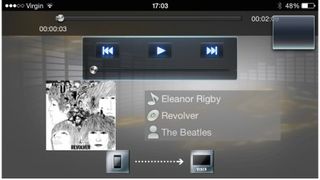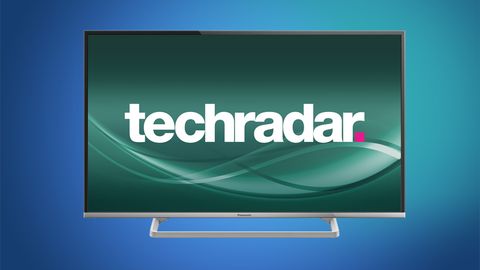Why you can trust TechRadar
Usability
My Home Cloud is one of the best smart TV innovations around, largely because it makes the whole concept of smart TV far bigger than just a list of apps.
Live TV – either as a large window or a small thumbnail – plays in the corner of every screen you navigate, with a choice between TV home screen, lifestyle screen and info screen (the latter of which can store four bookmarks for the TX-42AS600's surprisingly usable web browser).

The absence of ITV Player, 4OD and Demand Five apps are completely nullified by the presence of those services within Freetime. Though the platform's lack of Amazon Instant will put a reasonably large dent in the TX-42AS600's appeal.
Freetime
As well as boasting an excellent colour scheme, Freetime is easily the highlight on the TX-42AS600. The stylish division on the Freetime-flavoured 'Free Digital TV' version of My Home Screen is between shortcuts to TV guide, on demand, search TV and showcase sections, each of them colour-coded.
The TV guide makes it easy to browse to up to a week back in time to find on-demand content, showing previous broadcasts earlier that day, yesterday, and then by date back to seven days previously, with a 'watch now' or 'not available' sign beside it.

Channels where no on-demand material is included in Freetime can't be explored except for the now/next tab that pops-up on the screen if you press the OK button during live TV.
Sadly, scanning through the channel list is slow progress, with channel information loading gradually. It makes jumping back or forth between more than three or more adjacent channels time-consuming. Adding a layer of Freetime is welcome – and the design and use of channel logos adds a really professional look – but it needs to come with a tad more processing power.
Since Freetime is primarily a catch-up service, the on demand page is key. With just six apps available – BBC iPlayer, ITV Player, 4OD, Demand Five, BBC Sport and BBC News – this is simplicity itself. Netflix isn't part of Freetime, but it's only two button pushes away.

The search TV feature is nicely dynamic, with just a few letters punched-in using the remote bringing-up instant suggestions for TV programmes. During testing, the Showcase service was 'coming soon'.
Given the presence of Freetime navigation, the TX-42AS600 doesn't need to repeat features with its own electronic programme guide for Freeview HD. With far too much of a central role by dint of its shortcut guide button on the remote, it looks rather basic in comparison, though it does at least have a live TV thumbnail.
Remote control
The alternative to the long, well-weighted and big-buttoned standard remote is the Panasonic Remote 2 app for iOS and Android, but it's more than just a virtual version of the hardware. It allows text entry when the TX-42AS600's web browser is being used, and powers the novel Swipe & Share system of file-swapping between smartphone and TV.

Swipe & Share is remarkably easy to use, though file support is small. From a massive collection of files stored on a USB HDD connected to the TX-42AS600, the iOS app was only able to fetch and stream MP4 video files, though it down-converts from MP4 files of any resolution; even a batch of 4K MP4 files were successfully streamed to my smartphone.
As well as video, JPEG photos, and MP3, M4A and WAV music files are supported, with all files transferred instantly and playing very stably on a smartphone. For owners of a NAS drive, it's potentially exciting stuff, though probably best used only for photos. Swipe & Share also lets you stream videos, photos and music from a smartphone to the TX-42AS600, though in my test only videos filmed by a smartphone, in this case, a short MOV file in an iPhone's Camera Roll, could be transferred. The transfer, which is done by first playing the video within the app then physically swiping it towards the TV, takes about eight seconds. Music and photos transfer in half the time.

The app also includes all kinds of shortcuts to various features on the TX-42AS600, including to the full suite of apps; it goes way beyond rival brands' apps.
Digital media
While Swipe & Share is impressive, there's a much more hands-on feel to the TX-42AS600's handling of digital media files via its Media Player software. Accessing files from a networked PC or from a USB thumbdrive, the TX-42AS600 plays MKV, AVI, AVC HD, MPEG-2, MP4, WMV and WMV HD files, MP3, M4A, FLAC, WAV and WMA music, and JPEG photos.
Sound
The audio from the TX-42AS600's onboard 20W stereo speakers is not good. Thin and with very little dynamic range, only the music preset drags out any discernible low frequency action. However, dialogue is clear enough, though avoid the speech preset unless you're keen to kill most of the background noise.

Instead of creating a quasi-home cinema feel, the Surround option simply widens the soundstage a little, while adding an echo to the ball during matches at Wimbledon.
Value
Most of the value in the TX-42AS600 is wrapped-up in its smart TV antics. There is no cheaper way to get either Freetime, or a smart TV that carries all catch-up apps for the UK's terrestrial broadcasters. I'm not wholly convinced about the panel inside the TX-42AS600, but as a product for the living room there's simply nothing else available with as much smart stuff for this price.
Jamie is a freelance tech, travel and space journalist based in the UK. He’s been writing regularly for Techradar since it was launched in 2008 and also writes regularly for Forbes, The Telegraph, the South China Morning Post, Sky & Telescope and the Sky At Night magazine as well as other Future titles T3, Digital Camera World, All About Space and Space.com. He also edits two of his own websites, TravGear.com and WhenIsTheNextEclipse.com that reflect his obsession with travel gear and solar eclipse travel. He is the author of A Stargazing Program For Beginners (Springer, 2015),


